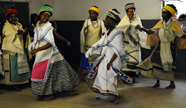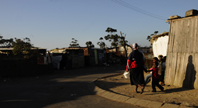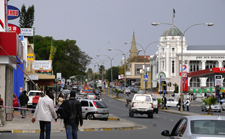November 7th, 2008
King William’s Town, South Africa | Khayelitsha, South Africa | Coahoma County, Mississippi
King William’s Town
Geography and Environs
Set in the rolling hills of the Eastern Cape, King William’s Town, or “King,” sprawls across the banks of the Buffalo River about 30 miles west of Port Elizabeth, which lies at the mouth of the river. The Buffalo River is the only navigable river in South Africa, giving King and Port Elizabeth an economic advantage, making them a key point of trade from the 19th century onward. King lies at the foot of the Amatola Mountains, after which the local Amathole Museum (formerly the Kaffrarian Museum, a racially derogatory term) was renamed.
The environs of King William’s Town are home to a number of other small towns and townships-a reflection of South Africa’s tumultuous history. Townships like Zwelitsha, Dimbaza, Phakamisa, and Schornville were created for those forcibly removed and as a funnel for labor to places like King. Ginsberg Township, the birthplace of Bantu Steve Biko, was originally created during an outbreak of the bubonic plague as a neighborhood for blacks from the surrounding rural areas. Bhisho (formerly Bisho), the site of the infamous 1992 massacre, is another major town near King, and now has a memorial near the site where the shooting occurred. While traveling through the environs of King, one will also encounter Steve Biko’s graveyard and home, the Amathole Museum, the Botanical Gardens, and even a memorial to Queen Victoria.
History
Originally founded in 1835 at the site of a mission built nine years earlier, King William’s Town-named for King William IV of England-soon became the premier trading outpost of the then British Kaffraria (the area of King and Port Elizabeth today). In 1857, a number of Germans who had fought in the Crimean War settled in the area, giving the distinctly German names to nearby places in the district such as Berlin and others. These German ex-soldiers effectively doubled the white population there, bringing it to nearly 4,000, as opposed to the Xhosa population which at the time numbered as many as 52,000. By 1889, the number of whites had climbed to over 8,000 and remained such for nearly a century. The 120,000 Xhosa, however, grew to over 630,000 by 1980.
 In 1880, King was connected to other towns by a railway, effectively making it the major trading center of the colony. This economic success was largely due to extensive trade with the indigenous African population, sending colonial goods in return for wool and animal hides. This influx of foreign goods and the colonizing effects of Christianity from the missions were major factors in the social and cultural subjugation of the native Ama Rharhabe Xhosa population. White society continued to flourish in King on the backs of black Africans who, in spite of their vast numerical superiority, were ultimately forced to submit to white domination.
In 1880, King was connected to other towns by a railway, effectively making it the major trading center of the colony. This economic success was largely due to extensive trade with the indigenous African population, sending colonial goods in return for wool and animal hides. This influx of foreign goods and the colonizing effects of Christianity from the missions were major factors in the social and cultural subjugation of the native Ama Rharhabe Xhosa population. White society continued to flourish in King on the backs of black Africans who, in spite of their vast numerical superiority, were ultimately forced to submit to white domination.
King’s fortuitous position on the banks of the Buffalo River made it not only a trading center, but also a military outpost until 1913, especially after trade began to decline at the turn of the century, in conjunction with the rise of Port Elizabeth. In 1901, King was hit by the bubonic plague, which prompted increased segregation of the town. Ginsberg, the township where Stephen Bantu Biko was later born, was founded as a response to the outbreak. Many Xhosa seeking economic opportunities came from the surrounding countryside to Ginsberg, where they faced exploitative white landlords. Furthermore, a new wave of Xhosa arrived when they were forcibly removed from nearby Brownlee Station. Segregation and ghettoization continued, most notably with the creation of new townships in the environs including Dimbaza, Phakamisa, Zwelitsha, and Schornville.
With the establishment of the Ciskei homeland between 1961 and 1981, Bhisho – a close neighbor of King William’s Town – became the capital of the new “sovereign” Bantustan (part of a series of “homelands” created by the apartheid government as a way pacifying black and international criticism). In 1992, nearly 80,000 people gathered in front of Bhisho to protest the authoritarian rule of Oupa Gqozo, the Ciskei military leader. Ciskei Defense Forces opened fire on the crowd without warning, killing 29 people and injuring over 200. The Bhisho Massacre ultimately led to new talks between Nelson Mandela and Frederik Willem de Klerk, then president of apartheid South Africa, which eventually resulted in a coalition government and transition to democracy.
Economy
The economy of King William’s Town was traditionally based on its proximity to local Xhosa tribes that exchanged wool, hides, skins, and other goods for manufactured and imported goods from European settlers. The massive amount of trade that occurred between the two groups contributed significantly not only to the economic success of King, but also to the erosion of traditional culture among indigenous blacks. Christianity, the influx of foreign goods, and urbanization made many Xhosa economically dependent on the whites – an effect later reproduced on a massive scale by the apartheid government to subjugate the African population of South Africa.
Trade in King William’s Town flourished in the latter half of the 19th century with the town becoming the main marketplace of nearby Port Elizabeth. The large amount of industry and its fortuitous location allowed merchants in King to trade with both settlers and native tribesmen. When Port Elizabeth outstripped it at the outset of the 20th century, King was reduced primarily to a military outpost. It wasn’t until the region was declared the “autonomous” Ciskei homeland in 1981 that the town once again began to regain economic status with the influx of Ciskeian workers and a subsequent budding service economy. Today, the economy of King William’s Town, though mostly based on cattle and sheep farming, also claims an industrial sector that produces textiles, soap, candles, candy, cartons, matches, and leather.
People
The Buffalo City Municipality – which includes King William’s Town, Bhisho, and East London – is home to people from a wide range of backgrounds.
Black African residents number at 563,776.
Coloured residents (from a diverse heritage of KhoiKhoi, South Asian, and other peoples) number at 38,391.
Indian residents (whose ancestors came when the area was still a British colony) number at 4,692
White residents number at 70,520.
Most neighborhoods in and around King William’s Town are overwhelmingly or even completely populated by black Africans from a number of different tribal heritages. Apartheid’s legacy of economic inequality along racial lines still continues today, although no longer at a legal level. That said, initiatives like Black Economic Empowerment, or BEE, aim at correcting these inequalities by encouraging people from the previously disadvantaged groups to enter higher levels of the economy. Comparable in many ways to affirmative action in the U.S., BEE has done much to diversify corporations and increase employment opportunities for the disadvantaged. It has, however, come under criticism from a number of people for reinforcing socially-constructed racial distinctions and giving favor to Xhosa at the expense of other groups, like Coloureds, Indians, and non-Xhosa blacks who did not escape the oppression or dispossession of apartheid either.
 Legacies of apartheid can still be seen everywhere. The townships created to house non-white laborers continue to be places of abject poverty and rampant crime. Though much has been done to correct the ills of apartheid, centuries of racial oppression and systematic dispossession cannot be reversed in a few years. Thus, in spite of the incredible leaps and strides made in South Africa, there is still much work to be done.
Legacies of apartheid can still be seen everywhere. The townships created to house non-white laborers continue to be places of abject poverty and rampant crime. Though much has been done to correct the ills of apartheid, centuries of racial oppression and systematic dispossession cannot be reversed in a few years. Thus, in spite of the incredible leaps and strides made in South Africa, there is still much work to be done.
(Photos on this page Copyright © 2010, Ryan Koons)
